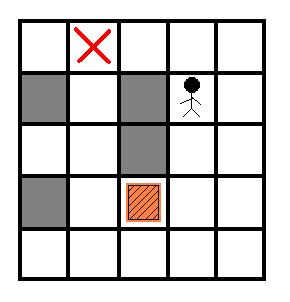hdu1254 推箱子(bfs+bfs)
阿新 • • 發佈:2019-01-26
推箱子
Time Limit: 2000/1000 MS (Java/Others) Memory Limit: 65536/32768 K (Java/Others)Total Submission(s): 6386 Accepted Submission(s): 1825
Problem Description 推箱子是一個很經典的遊戲.今天我們來玩一個簡單版本.在一個M*N的房間裡有一個箱子和一個搬運工,搬運工的工作就是把箱子推到指定的位置,注意,搬運工只能推箱子而不能拉箱子,因此如果箱子被推到一個角上(如圖2)那麼箱子就不能再被移動了,如果箱子被推到一面牆上,那麼箱子只能沿著牆移動.
現在給定房間的結構,箱子的位置,搬運工的位置和箱子要被推去的位置,請你計算出搬運工至少要推動箱子多少格.

Input 輸入資料的第一行是一個整數T(1<=T<=20),代表測試資料的數量.然後是T組測試資料,每組測試資料的第一行是兩個正整數M,N(2<=M,N<=7),代表房間的大小,然後是一個M行N列的矩陣,代表房間的佈局,其中0代表空的地板,1代表牆,2代表箱子的起始位置,3代表箱子要被推去的位置,4代表搬運工的起始位置.
Output 對於每組測試資料,輸出搬運工最少需要推動箱子多少格才能幫箱子推到指定位置,如果不能推到指定位置則輸出-1.
Sample Input 1 5 5 0 3 0 0 0 1 0 1 4 0 0 0 1 0 0 1 0 2 0 0 0 0 0 0 0
Sample Output 4
Author Ignatius.L & weigang Lee 分析:bfs巢狀bfs,一個搜人的軌跡,一個搜箱子的軌跡。
#include <iostream> #include <cstdio> #include <cstring> #include <stack> #include <queue> #include <map> #include <set> #include <vector> #include <cmath> #include <algorithm> using namespace std; const double eps = 1e-6; const double pi = acos(-1.0); const int INF = 0x3f3f3f3f; const int MOD = 1000000007; #define ll long long #define CL(a,b) memset(a,b,sizeof(a)) int n,m; int mat[11][11],dir[4][2]= {{0,1},{0,-1},{1,0},{-1,0}}; bool vis[11][11][4],vm[11][11]; int man_x,man_y,box_x,box_y,en_x,en_y; struct A { int x,y; }; struct node { int step; struct A box,man; }; bool bb(int b_x, int b_y, int m_x, int m_y, int k)//搜人是否能到達要推的位置 { CL(vm, false); queue<node> qq; node ss,tt; ss.man.x=m_x; ss.man.y=m_y; vm[ss.man.x][ss.man.y]=true; vm[b_x][b_y]=true;//當前箱子的位置標記不可訪問 qq.push(ss); while(!qq.empty()) { ss=qq.front(); qq.pop(); if(ss.man.x+dir[k][0]==b_x&&ss.man.y+dir[k][1]==b_y) return true; for(int i=0; i<4; i++) { tt.man.x=ss.man.x+dir[i][0]; tt.man.y=ss.man.y+dir[i][1]; if(mat[tt.man.x][tt.man.y]!=0) continue; if(!vm[tt.man.x][tt.man.y]) { vm[tt.man.x][tt.man.y]=true; qq.push(tt); } } } return false; } void bfs()//搜箱子的軌跡 { queue<node> q; node now,next; now.box.x=box_x; now.box.y=box_y; now.man.x=man_x; now.man.y=man_y; now.step=0; q.push(now); while(!q.empty()) { now=q.front(); q.pop(); if(now.box.x==en_x&&now.box.y==en_y) { cout<<now.step<<endl; return ; } for(int i=0; i<4; i++) { next.box.x=now.box.x+dir[i][0]; next.box.y=now.box.y+dir[i][1]; //cout<<bb(now.box.x, now.box.y, now.man.x, now.man.y, i)<<endl; if(vis[next.box.x][next.box.y][i]||mat[next.box.x][next.box.y]!=0) continue; if(bb(now.box.x, now.box.y, now.man.x, now.man.y, i))//如果人能走到推箱子的位置 { vis[next.box.x][next.box.y][i]=true; next.man.x=now.box.x;//人推箱子後的位置變為之前箱子的位置 next.man.y=now.box.y; next.step=now.step+1; q.push(next); } } } cout<<"-1"<<endl; } int main() { int T; cin>>T; while(T--) { CL(mat, -1);//地圖初始化,邊界全為-1 cin>>n>>m; for(int i=1; i<=n; i++) { for(int j=1; j<=m; j++) { cin>>mat[i][j]; if(mat[i][j]==2)//人、箱子和終點的位置儲存好,再把地圖中相應位置變為可走,即0 { box_x=i; box_y=j; mat[i][j]=0; } if(mat[i][j]==3) { en_x=i; en_y=j; mat[i][j]=0; } if(mat[i][j]==4) { man_x=i; man_y=j; mat[i][j]=0; } } } CL(vis, false); bfs(); } return 0; }
